Toward the middle of Balzac’s Cousin Pons, the reader encounters a passage that introduces the new phenomenon of photography. The narrator has just expressed the sentiment that to believe in divination, such as fortune-telling, is to believe in the absurd.
But this criterion of absurdity once ruled out the harnessing of steam; it still rules out aerial navigation; it ruled out many inventions: gunpowder, printing, the telescope, engraving and also the most recent great discovery of our time, the daguerreotype. If anyone had come and told Napoleon that a man or a building is incessantly and continuously represented by a picture in the atmosphere, that all existing objects project into it a kind of spectre which can be captured and perceived, he would have consigned him to Charenton as a lunatic, just as Cardinal Richelieu consigned Salomon de Caux to Bicêtre when that martyred Norman put within his grasp a tremendous victory over nature: navigation by steam. And yet that is what Daguerre’s discovery proved!1
Cousin Pons was written in the early 1840s, only a handful of years after Daguerre demonstrated his new invention for the French Academy of Sciences and the public. Balzac finds photography disconcerting. For him, the human character, from gestures and manners to complex motivations and secret vices, was something made visible to the keen observer, the human narrator of his fiction. The idea that a machine could “incessantly and continuously represent” a “spectre,” or that we might be giving off images of ourselves that the camera could capture, was deeply unsettling. Édouard Manet did not share Balzac’s reservations (or maybe superstitions?) about photography, and indeed several scholars have noted photographic models for particular works by Manet.2 I would argue that we need to look more specifically at the kinds of formal effects typical of photography at mid-century in order to see Manet’s profound engagement with this new image paradigm. We also need to think about the photograph as an image whose source was not human, but optical and mechanical, and thus mysterious. Like Balzac, Manet was primarily concerned with the human, social world, but in Manet’s case, the ommatophore of the camera—the automatism of an eye on a stalk—has a greater presence than we have previously acknowledged.
Perhaps what is most startling about photography is that we expect photographs—those products of lens, machine, and chemistry— to be accurate, neutral, “scientific” images, when in fact they turn out to be something else. We expect the world to appear in black and white, for instance. Prior to the development of orthochromatic emulsions in 1873, however, the entire value scale of a landscape was somewhat unpredictable: greens in nature, for example, could look quite dark in early paper prints. When Édouard Baldus made a salted paper print of some friends on a country retreat, the Château de la Faloise almost vanishes in the center of the picture (fig. 1).3
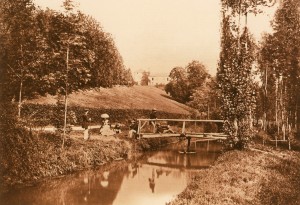
A lady’s parasol becomes a floating mushroom cap: it is a large white shape with no visible handles or structures. Both the lady’s dress and her friend’s bright trousers are noticeably too bright, as is the little path behind them, which resembles a beam of light. The man in light trousers standing on the bridge, meanwhile, becomes a tonal inversion as his form is reflected as a long and heavy shape in the water. Light legs become dark; his whole body lengthens; a hatted head becomes a peg. Trees that probably looked lush and full to the persons on site seem to bristle against the white sky in the photograph. Lady Eastlake, writing about landscape photography in 1857, complained about these very phenomena, especially the house looking like a “card-box, with black blots of trees on each side, all rooted in a substance far more like burnt stubble than juicy, delicate grass.”4 Imagine a viewer whose understanding of the French landscape was based on the silvery light of Corot or the humid atmosphere of Daubigny; now imagine that viewer coming face to face with this print. She or he would wonder what kind of climate this was, or whether ordinary sunlight pushed soft grasses and poplar leaves to such extremes of light and dark. A nineteenth-century landscape painter would probably have softened the appearance of the foliage, and a portraitist would have heightened the definition of the château, the figures, and the relations among them. No painter had ever rendered the obdurate tones and geometry of the underside of a bridge and the intricate reflections of tree trunks, posts, and rails so insistently as they appear in Baldus’ print.
In order to appreciate how a painter of Manet’s generation would have viewed early photographs, it is necessary to think past our own familiarity with photographic images to try to see how these new images first appeared in their own time. Portraiture was one of the first artistic genres to change as a result of the availability of photographic portraits at mid-century; at the same time, the photographic portrait was capable of producing effects that would be daring in a nineteenth-century painting. If Julia Margaret Cameron’s subject, Philip Stanhope Worsley, didn’t look so Victorian, we might take him to be the model for a Cubist harlequin, with a mask of shadow overtaking the left side of the face, and his eye emerging out of the darkness (fig. 2).
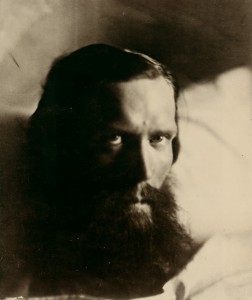
Cameron’s choice of high contrast lighting was deliberate and meant to be expressive, but at the same time, her deployment of extremes to illuminate her subject reminds us that artificial light potentially introduces high value contrast to the scene. The lighting of a face could be extreme in a photograph in ways that painters of the time would certainly have found to be novel and evocative.5
Photography could be called upon to do many kinds of documentary work, but for painters, it was perhaps even more significant that there were things it could not register. Take, for example, Baldus’s 1855 photograph of the train station at Amiens, part of an album commissioned by Baron James de Rothschild to commemorate the train line from Paris to Boulogne (fig. 3).6
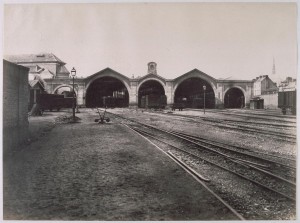
Baldus’ long exposure allows us to see into the shadows of the train sheds even as we admire the severe geometry of the architecture. The image does record the contingent: the pattern of diverging rails, the robotic signaling mechanism, the impressions of so many footsteps in the soft earth. But that very long exposure allows for no incident in the sky or on the tracks—no movement, no life, nothing ephemeral. Manet’s Railway of 1873 is the photograph’s polar opposite, with its brightness, its high-key color, and its focus on two vividly represented actors (fig. 4).
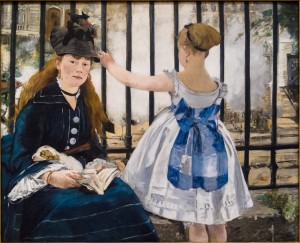
A glance up at the viewer, a girl grasping a rail, fingers holding a page in a book: everywhere in the painting, from the workers in the distance to the dozing puppy, we see the kind of incident and ephemerality that Baldus could not capture.7 Manet’s enormous clouds of steam have depth and definition; even as they are known to be fleeting, they have form. No photograph from 1873 could capture so many different varieties of momentariness as Manet’s painting. His addition of a bunch of grapes on the ledge at right creates a visual rhyme—the clouds of steam are like a bunch of grapes—in case we missed his display of what painting could do that photography in 1873 could not. Although Manet clearly engaged with photography by thinking through it visually in ways I hope to illuminate, he could also marshall painting’s means of outdoing the newer art.
Art historians have noted that Courbet’s response to photography was, by turns, both imitative and oppositional.8 For example, Gustave Le Gray’s Great Wave, Sète, has been exhibited as a precedent for Courbet’s late Wave paintings (figs. 5, 6).
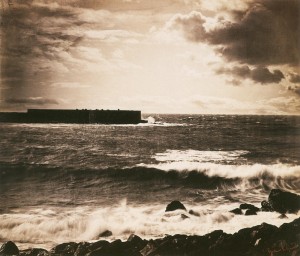
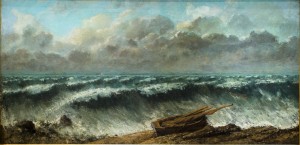
The sheer bravura of Courbet’s palette-knife technique is immediately apparent; one sees why Benjamin called Courbet “the last who could attempt to surpass photography.”9 Look again at Le Gray, however. Against all odds, working under a dark cloth, composing on the view-camera’s ground glass with its image reversed and upside-down, he manages to create an image of a wave’s absolute uniqueness in space and time. We see the wave in all its phases: it crashes forward, it begins to turn, the water peaks. In Le Gray, we see the suggestion of elapsed time via the wave’s displacement across space. Courbet, by contrast, is not painting with optical attentiveness: he comes up with a brilliant painterly trick to represent the cresting wave just beginning to cascade, and he does it again and again. He impresses us with his laying-on of paint, but he does not capture what the wave does in an instant. Although he probably saw Le Gray’s Wave, he did not paint what Le Gray’s camera registered. Like Courbet, Manet must have looked at Le Gray’s marine photographs, and like the older Realist, Manet may well have looked rather deeply into certain uniquely photographic effects, even if he then challenged them in paint. I am struck by the glassiness of the water and the shadowy wakes in Le Gray, The French Fleet, Cherbourg (fig. 7).
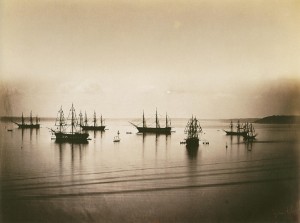
Le Gray’s sky has only mere traces of clouds; he does not try to layer on dramatic clouds from another exposure as he so often did. His plate records an overall mood of calmness, but at the same time registers innumerable shadows, reflections, wakes, vibrations in the water. In The Tugboat, Le Gray relies on a shorter exposure time to capture the tugboat’s heavy black smoke seen against the sky (fig. 8).10

The brief exposure makes the water dark with a rougher surface, and the ship is merely a small silhouette in the middle of the vignette of light. Perhaps Manet responds to something like the glossy water of the French Fleet and the trail of smoke in The Tugboat in his painting Steamboat Leaving Boulogne (fig. 9).
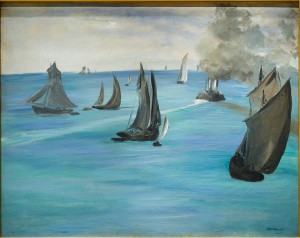
He creates an image with his characteristic insouciance: this is one of his most spare and rapidly painted works from 1864. Manet paints sailboats that are simple shapes, summarily painted over a glassy blue surface. What appears at first glance to be a painting in the genre of Le Gray’s seascapes, though, emerges as a uniquely painterly intervention. Unlike Le Gray’s imprint of every shadow and every ripple in the water’s surface, Manet’s water reflects almost nothing. Manet contrives an alternation of warm and cool blues that record only the most minimal shadow from tall sailboats such as the one in the painting’s center, and no shadow to speak of for the sailboat at right, clearly painted right on top of the blue. The steamboat, meanwhile, leaves a white wake and a brown shadow while it belches smoke. Manet’s attention to its activities renders his sailboats even more flat and toylike by comparison. If his composition recalls Le Gray’s seascapes, Manet’s selectivity remains stubbornly resistant to photography’s indiscriminateness.
Photography is, of course, an abstraction: it is an abstraction of a chaotic world into a non-colored set of tonalities that is nevertheless visually rich and geometrically constrained. I would suggest that some of the tonal abstractions that could be seen in mid-century photography enabled Manet to see the world differently, and ultimately, to take more liberties with painting it differently. Henri Le Secq’s view of the public baths provides one such example (fig. 10).
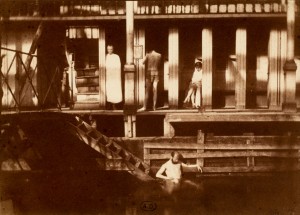
The photograph reveals glimpses of a few male bathers: one standing like a column, one hardly visible except for light grazing his thigh, one with legs akimbo, one gingerly lowering himself into the water. For a visitor to the baths in 1852, the scene would probably have looked rather ordinary, yet in the photograph, the building and bathers become a startling, abstract pattern of revealings and concealments. Works of art make us see the world anew, and having seen photographs like Le Secq’s, Manet must have seen the light hitting the piers of a jetty with a heightened attentiveness to superimposed geometries and tonal distinctions; the Jetty at Boulogne is a painting after photography (fig. 11).
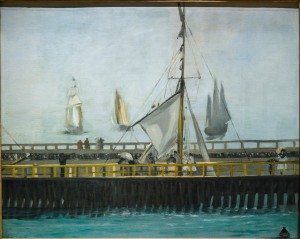
Although strong value contrast had always been an element of Manet’s work, a painting like the Jetty at Boulogne makes the most of the intricate play of accentuations created by the fall of light on the back side of the railing, while facing posts are a neutral value and others in deep shadow. It is true that the human eye can detect these variations, but it is striking that painting in the 1860s becomes more attuned to such abstract patterns in the wake of photographs such as Le Secq’s, with the brilliant light on the columns and the different levels of shadow playing between and across them.
Writers on the relationship between photography and painting did not initially focus on the kinds of formal devices that could be shared between the two arts. Many critics and viewers agreed with Baudelaire’s attitude that photography was best suited to being the handmaiden of science, separate from the domain of art. As late as 1936, the painter and critic André Lhote could claim that “the much-discussed replacement of painting by photography has its proper place in what might be called the ‘ongoing business’ of painting. But that still leaves room for painting as the mysterious and inviolable domain of the purely human.”11 Lhote’s statement sounds harmless enough, perhaps even comforting: let photography be accurate and scientific, and art will take care of the human world. Balzac, however, tells us something else. I take Balzac’s text, absurd as it is, to be commingling technology and the human. Balzac would not worry about the photographic image if it were safely consigned to the realm of science, merely rendering useful documentary work, and leaving to art the domain of the human. For Balzac, the photograph, the “specter,” is lurking out there, as the camera is always ready to capture images of us that we cannot predict or control. The photograph already occupies the realm of the human. Art has to explore this uneasy conjunction if it is truly to respond to the conditions of the modern world. This is where I think we find Manet: he is alive to the ways in which photography could reveal images of us that were not authored, or maybe even authorized, by us.
In the ballet Coppélia, an inventor creates a mechanical doll so lifelike that a young man begins to neglect his fiancée as he pursues it. Photography was the Coppélia of the art world in the middle of the nineteenth century; like the mechanical doll of the ballet, it was appealing and strange; human and machine. Like the villagers around Coppélia, nineteenth-century viewers were alternatingly duped or made suspicious. Balzac was far from alone in his fear that the taking of the photograph would remove an outer layer or two from his person.12 Other writers and artists of the time spoke of the photographic image as a kind of double or doppelgänger. Daguerre had already spoken of “the spontaneous reproduction of images of nature received in the camera obscura.”13 Oliver Wendell Holmes compared the “evanescent films” of the stereograph to the ancient belief that “all bodies were continually throwing off certain images like themselves, which subtile emanations, striking on our bodily organs, gave rise to our sensations.”14 Still others expressed more concern about what the photograph revealed or expressed. Nathaniel Parker Willis and Timothy O. Porter exclaimed, “The telescope is rather an unfair tell-tale; but now every thing and every body may have to encounter his double every where, most inconveniently, and thus everyone [must] become his own caricaturist.”15 Edmond de Goncourt wrote that photography seemed to capture “only the animality contained in the man or woman represented.”16 It is clear from the imagery of these writers that photography, despite its mechanical origins, was likened to something unconscious: it could even be animalistic in its automatism. It was a matter of concern that the photograph could reveal something over which the sitter had no conscious control.
Photography in the nineteenth century can be said to have authored a new type of self-consciousness, as the photograph could make visible an image that a person exuded like a scent. Since the camera could “take” an exposure without the sitter’s knowledge, though, the sitter did not truly produce the image the way a portrait painter produces a portrait. Like the image in Lacan’s mirror stage, the photograph could inaugurate a split, a feeling of lack of fit between the way we are seen by others and how we feel ourselves to be.17 But unlike Lacan’s mirror image, the photograph so often was not an idealized representation, but rather, a terribly awkward one. Some of the earliest photographic portraits we have, by David Octavius Hill and Robert Adamson in the mid-1840s, periodically feature sitters clearly unused to looking at themselves, much less able to project an image of themselves that anticipated the gaze on the other side of the lens (fig. 12).18
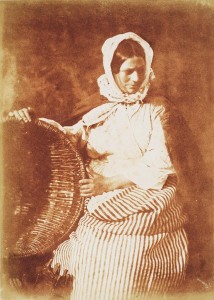
The extreme camera-shyness of the mid-‘40s gives way to some knowledge of what the act of posing is for, and the next wave of photographic portraits features clients straining to hold their expressions (fig. 13).
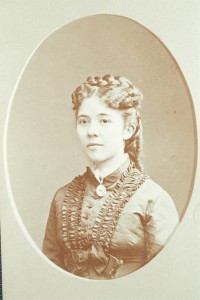
They look stiff at times, blank at others as they unwittingly register their submission to the photographic regime. Manet seems to have embraced this blankness as a condition for modern posing. Several art historians and critics have addressed the ways in which photography—specifically the photography of the 1850s and early ‘60s—might have been influential to Manet. Both Anne McCauley, who has written on Manet’s acceptance of the “inherent falsity and stylistic peculiarities” of photographic prints, and Carol Armstrong, who notes that Manet drew on photography “to make [the portrait] boldly strange,” have responded to the overall look of mid-century photographic portraiture and its resonance in Manet’s figure paintings.19 Artist Alexi Worth recounts that a session looking at photographs of nude models in the 1850s changed the way Delacroix saw the engravings of Marcantonio Raimondi; for Worth, Manet then picked up where Delacroix left off in trying to make the contemporary “dissonance between Marcantonio and photography” into paintings.20 All three of these writers would have us think anew about the strange and novel aspects of the technical appearance of photographs in the mid-nineteenth century. I think it is worth accepting their assertions and building upon them by continuing to look closely at particular examples of period photographs and their formal effects.
When Charles Hugo set out to photograph his father Victor, he somewhat overexposed the portraits, resulting in very light foreheads and deep shadows in the eye sockets, an effect that may well lie behind the overlit Street Singer by Manet, with its bright forehead and the two “commas” of shadow, as one critic called them, on either side of Victorine’s nose (figs. 14, 15).
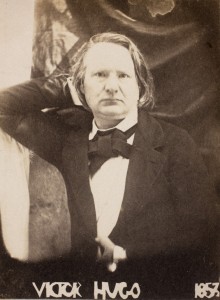
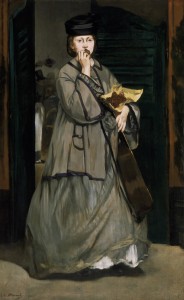
Elizabeth Rigby, later Lady Eastlake, emerges as one of the most lucid evaluators of photography’s strengths and weaknesses in 1857. “Though the faces of our children may not be modeled and rounded with that truth and beauty which art attains, yet minor things—the very shoes of the one, the inseparable toy of the other—are given with a strength of identity which art does not even seek.”21 The shoes and toy may well be Lady Eastlake’s punctum, objects that capture her attention in photographs despite their relative meaninglessness.22 Could photography’s incidental inclusion of objects with no narrative purpose have become an aspect of period style that Manet recreated in portraits such as Théodore Duret, with its inexplicable carafe, glass, and lemon at right (Fig. 16)?
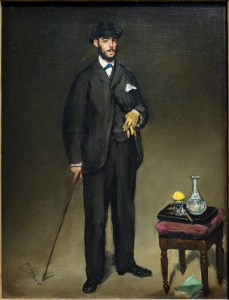
Lady Eastlake was fully capable of appreciating photography’s unique properties, but was in no doubt about its artistic limitations when it came to the human countenance. “The likeness to Rembrandt and Reynolds is gone!” she proclaimed.23 A woman’s rouged cheek looked blotchy; women’s hair, “if very glossy,” “is cut up into lines of light as big as ropes.”24 She made a further observation of 1850s portrait photography, for her a negative: “[The] fineness of skin peculiar to the under lip reflects so much light, that in spite of its deep colour it presents a light projection, instead of a dark one.”25 We are so accustomed to reading photographs now that this effect no longer stands out to us; J. G. Ellinwood’s tintype portrait looks straightforward enough (fig. 17).
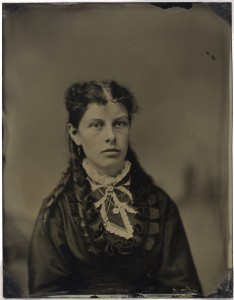
But consider the nineteenth-century viewer familiar with painted portraits such as those of Jean-Auguste Dominique Ingres (fig. 18).
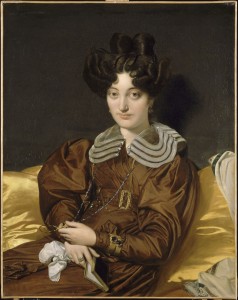
The upper and lower lips of Madame Marcotte de Sainte-Marie in Ingres’ portrait are the same rose color, unlike those of the woman in the photographic portrait. No wonder Lady Eastlake found it unnatural and unflattering that the photograph renders the lower lip light and the upper lip dark. Manet clearly noticed this odd artifact of early portrait photography, and chose to imitate it: Victorine’s lower lip pales in the Portrait of Victorine Meurent, even as her upper lip has a more natural dark color (fig. 19).
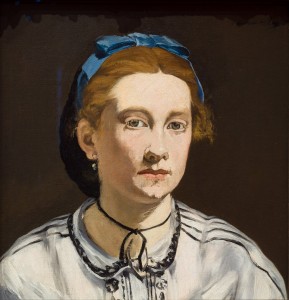
It is in details like these that we see Manet not only visually attuned to the features peculiar to portrait photographs of his time, but also in effect saying in paint that photography offered a new kind of image of us; photographic seeing was modern seeing.
Contingency—that quality T. J. Clark has identified as intrinsic to modernism—is the ineluctable fact of photography.26 “Every form which is traced by light is the impress of one moment, or one hour, or one age in the great passage of time,” wrote Lady Eastlake.27 Photography’s contingent character gave us the stiffness of Baldus’s friends on the lawn of the Château de La Faloise, aligned with bench and chairs, hatted, parasol-ed, and bored (fig. 20).
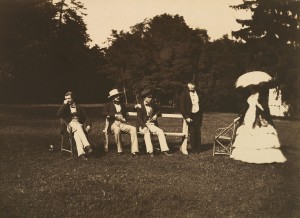
The world of Manet’s Croquet Party at Boulogne appears here, with the taking of the photograph supplying the distraction that the game of croquet provided for Manet’s friends (fig. 21).
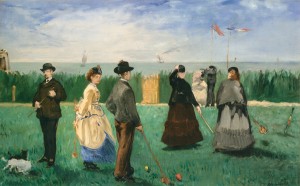
Baldus’ Self-Portrait in the Tuileries Gardens offers a combination of sharp delineation and softer garden backdrop that Manet imitated in his Portrait of George Moore (figs. 22, 23).

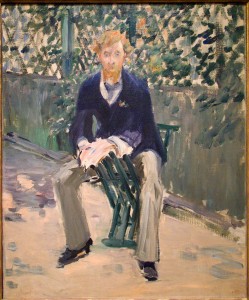
Charles Nègre’s exposure of a man standing in front of a French door must have been familiar to Manet when he posed his group of friends on the balcony of his Boulogne summer studio (figs. 24, 25).
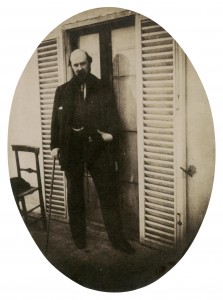
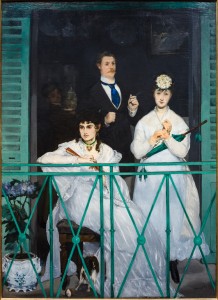
Both photograph and painting represent particular persons, not social types, dressed in the fashions of the day. Manet’s modern life painting has long been thought to synthesize aspects of portraiture and genre painting. It may be the case that photography pointed the way toward a painting of modern life that highlighted particularity rather than universality: the painter represents recognizable persons, places, and moments rather than activities typical of a larger class. The Balcony combines what we might call this contingent or highly particularized approach to its subject with a formal effect that is also photographic: the way the heads emerge out of the darkness—black hair against shadowed interior—seems distinctly reminiscent of early photography’s high value contrasts.
Despite Baudelaire’s regret, finally it was photography that was capable of showing us “how great and poetic we are in our cravats and our patent leather boots.”28 Such a claim is perhaps too easy to make, however, or it sounds too sunny, even if we remember Baudelaire’s objections to the new art. Photography made it clear that the future had arrived, and we would now encounter our doubles everywhere; even before the first tweet or status update, photography had already made us our own caricaturists.
In the ballet Coppélia, the young female lead, Swanhilda, becomes jealous of the mechanical doll Coppélia’s beauty, and of her lover Franz’s enthrallment with the doll. Swanhilda must outwit both her boyfriend and the doll’s inventor, Dr. Coppélius, by posing as Coppélia and by pretending that the doll has come to life. Manet’s engagement with photography can be compared with Swanhilda’s response to Coppélia. Photography was among us; it irrevocably became part of the social fabric. It did not stay in the domain of science any more than the doll stayed in the mad inventor’s shop. A painting of modern life would have to find a way to represent the rapport between technology and the human world, between photography and painting. The banal particularity of the man on the balcony, the pale lower lip, the punctum of the accessories—they were part of how we looked as well as how we saw.
Walter Benjamin had a name for the phenomenon of the camera’s registration of what the human eye, molded by culture and sensibility, could not see: he called it the “optical unconscious.”29 Benjamin was referring to the previously unseen stages of human and animal locomotion, finally revealed in the photographic experiments of Étienne-Jules Marey and Eadweard Muybridge. Invoking Benjamin, Rosalind Krauss has wielded the concept in her analysis of Surrealist collage, photography, the readymade, and their place in the history of modernism.30 I think the term works well to capture early photography’s strangeness, its uncanny, its way of giving us pictures that we present to the world without entirely authoring or controlling them. There is in the optical unconscious a palpable distance between a felt mode of self-presentation and an awareness of external observation.
The workplace differs from ordinary life in that it is place where activities are surveyed, a place in which we are aware of external observation and judgment. Manet could not have seen this photograph, from the Seabury & Johnson Company in East Orange, New Jersey, in the late 1880s, but I imagine he saw a similar kind of image somewhere along the way (fig. 26).31
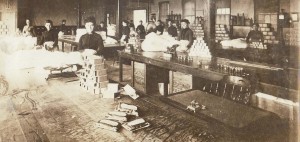
Seabury and Johnson manufactured medical and surgical supplies such as sterile gauze. Here, the employees pause in their work and wait for the photographer to capture them at their stations. It is a look of professional comportment in a state of suspended animation, as if the young women are awaiting the boss’ inspection. It is a look we have seen before in Manet’s painting.
The atmosphere at the Folies-Bergère is dazzling and laden with pleasures; it is a far cry from the sobriety of the Seabury & Johnson workroom, but the woman’s look is the same (fig. 27).
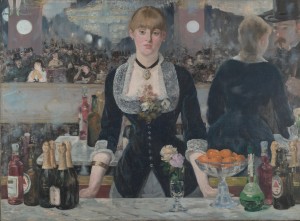
The barmaid may as well be waiting for the tell-tale click of the photographer’s shutter. Manet challenges us to make sense of the discrepancy between the barmaid and her mirror image. Her expression is the suppression of spontaneity in favor of a professional look: we might also call it the meeting of the barmaid and the photograph. In the mirror, we see her engagement with the man and her participation in a form of social life that runs counter to the blankness before us. Walter Benjamin’s words come to mind: “Immersed long enough in such a picture, one recognizes to what extent opposites touch.”32 Manet makes painting and photography—the sensuous and the spectral—touch, and only Manet would put the older form of sociability in the mirror, as if in the past. The here-and-nowness of the image, the model’s gaze, eternally faces out.
Notes
Toward the middle of Balzac’s Cousin Pons, the reader encounters a passage that introduces the new phenomenon of photography. The narrator has just expressed the sentiment that to believe in divination, such as fortune-telling, is to believe in the absurd.
But this criterion of absurdity once ruled out the harnessing of steam; it still rules out aerial navigation; it ruled out many inventions: gunpowder, printing, the telescope, engraving and also the most recent great discovery of our time, the daguerreotype. If anyone had come and told Napoleon that a man or a building is incessantly and continuously represented by a picture in the atmosphere, that all existing objects project into it a kind of spectre which can be captured and perceived, he would have consigned him to Charenton as a lunatic, just as Cardinal Richelieu consigned Salomon de Caux to Bicêtre when that martyred Norman put within his grasp a tremendous victory over nature: navigation by steam. And yet that is what Daguerre’s discovery proved!1
Cousin Pons was written in the early 1840s, only a handful of years after Daguerre demonstrated his new invention for the French Academy of Sciences and the public. Balzac finds photography disconcerting. For him, the human character, from gestures and manners to complex motivations and secret vices, was something made visible to the keen observer, the human narrator of his fiction. The idea that a machine could “incessantly and continuously represent” a “spectre,” or that we might be giving off images of ourselves that the camera could capture, was deeply unsettling. Édouard Manet did not share Balzac’s reservations (or maybe superstitions?) about photography, and indeed several scholars have noted photographic models for particular works by Manet.2 I would argue that we need to look more specifically at the kinds of formal effects typical of photography at mid-century in order to see Manet’s profound engagement with this new image paradigm. We also need to think about the photograph as an image whose source was not human, but optical and mechanical, and thus mysterious. Like Balzac, Manet was primarily concerned with the human, social world, but in Manet’s case, the ommatophore of the camera—the automatism of an eye on a stalk—has a greater presence than we have previously acknowledged.
Perhaps what is most startling about photography is that we expect photographs—those products of lens, machine, and chemistry— to be accurate, neutral, “scientific” images, when in fact they turn out to be something else. We expect the world to appear in black and white, for instance. Prior to the development of orthochromatic emulsions in 1873, however, the entire value scale of a landscape was somewhat unpredictable: greens in nature, for example, could look quite dark in early paper prints. When Édouard Baldus made a salted paper print of some friends on a country retreat, the Château de la Faloise almost vanishes in the center of the picture (fig. 1).3

A lady’s parasol becomes a floating mushroom cap: it is a large white shape with no visible handles or structures. Both the lady’s dress and her friend’s bright trousers are noticeably too bright, as is the little path behind them, which resembles a beam of light. The man in light trousers standing on the bridge, meanwhile, becomes a tonal inversion as his form is reflected as a long and heavy shape in the water. Light legs become dark; his whole body lengthens; a hatted head becomes a peg. Trees that probably looked lush and full to the persons on site seem to bristle against the white sky in the photograph. Lady Eastlake, writing about landscape photography in 1857, complained about these very phenomena, especially the house looking like a “card-box, with black blots of trees on each side, all rooted in a substance far more like burnt stubble than juicy, delicate grass.”4 Imagine a viewer whose understanding of the French landscape was based on the silvery light of Corot or the humid atmosphere of Daubigny; now imagine that viewer coming face to face with this print. She or he would wonder what kind of climate this was, or whether ordinary sunlight pushed soft grasses and poplar leaves to such extremes of light and dark. A nineteenth-century landscape painter would probably have softened the appearance of the foliage, and a portraitist would have heightened the definition of the château, the figures, and the relations among them. No painter had ever rendered the obdurate tones and geometry of the underside of a bridge and the intricate reflections of tree trunks, posts, and rails so insistently as they appear in Baldus’ print.
In order to appreciate how a painter of Manet’s generation would have viewed early photographs, it is necessary to think past our own familiarity with photographic images to try to see how these new images first appeared in their own time. Portraiture was one of the first artistic genres to change as a result of the availability of photographic portraits at mid-century; at the same time, the photographic portrait was capable of producing effects that would be daring in a nineteenth-century painting. If Julia Margaret Cameron’s subject, Philip Stanhope Worsley, didn’t look so Victorian, we might take him to be the model for a Cubist harlequin, with a mask of shadow overtaking the left side of the face, and his eye emerging out of the darkness (fig. 2).

Cameron’s choice of high contrast lighting was deliberate and meant to be expressive, but at the same time, her deployment of extremes to illuminate her subject reminds us that artificial light potentially introduces high value contrast to the scene. The lighting of a face could be extreme in a photograph in ways that painters of the time would certainly have found to be novel and evocative.5
Photography could be called upon to do many kinds of documentary work, but for painters, it was perhaps even more significant that there were things it could not register. Take, for example, Baldus’s 1855 photograph of the train station at Amiens, part of an album commissioned by Baron James de Rothschild to commemorate the train line from Paris to Boulogne (fig. 3).6

Baldus’ long exposure allows us to see into the shadows of the train sheds even as we admire the severe geometry of the architecture. The image does record the contingent: the pattern of diverging rails, the robotic signaling mechanism, the impressions of so many footsteps in the soft earth. But that very long exposure allows for no incident in the sky or on the tracks—no movement, no life, nothing ephemeral. Manet’s Railway of 1873 is the photograph’s polar opposite, with its brightness, its high-key color, and its focus on two vividly represented actors (fig. 4).

A glance up at the viewer, a girl grasping a rail, fingers holding a page in a book: everywhere in the painting, from the workers in the distance to the dozing puppy, we see the kind of incident and ephemerality that Baldus could not capture.7 Manet’s enormous clouds of steam have depth and definition; even as they are known to be fleeting, they have form. No photograph from 1873 could capture so many different varieties of momentariness as Manet’s painting. His addition of a bunch of grapes on the ledge at right creates a visual rhyme—the clouds of steam are like a bunch of grapes—in case we missed his display of what painting could do that photography in 1873 could not. Although Manet clearly engaged with photography by thinking through it visually in ways I hope to illuminate, he could also marshall painting’s means of outdoing the newer art.
Art historians have noted that Courbet’s response to photography was, by turns, both imitative and oppositional.8 For example, Gustave Le Gray’s Great Wave, Sète, has been exhibited as a precedent for Courbet’s late Wave paintings (figs. 5, 6).


The sheer bravura of Courbet’s palette-knife technique is immediately apparent; one sees why Benjamin called Courbet “the last who could attempt to surpass photography.”9 Look again at Le Gray, however. Against all odds, working under a dark cloth, composing on the view-camera’s ground glass with its image reversed and upside-down, he manages to create an image of a wave’s absolute uniqueness in space and time. We see the wave in all its phases: it crashes forward, it begins to turn, the water peaks. In Le Gray, we see the suggestion of elapsed time via the wave’s displacement across space. Courbet, by contrast, is not painting with optical attentiveness: he comes up with a brilliant painterly trick to represent the cresting wave just beginning to cascade, and he does it again and again. He impresses us with his laying-on of paint, but he does not capture what the wave does in an instant. Although he probably saw Le Gray’s Wave, he did not paint what Le Gray’s camera registered. Like Courbet, Manet must have looked at Le Gray’s marine photographs, and like the older Realist, Manet may well have looked rather deeply into certain uniquely photographic effects, even if he then challenged them in paint. I am struck by the glassiness of the water and the shadowy wakes in Le Gray, The French Fleet, Cherbourg (fig. 7).

Le Gray’s sky has only mere traces of clouds; he does not try to layer on dramatic clouds from another exposure as he so often did. His plate records an overall mood of calmness, but at the same time registers innumerable shadows, reflections, wakes, vibrations in the water. In The Tugboat, Le Gray relies on a shorter exposure time to capture the tugboat’s heavy black smoke seen against the sky (fig. 8).10

The brief exposure makes the water dark with a rougher surface, and the ship is merely a small silhouette in the middle of the vignette of light. Perhaps Manet responds to something like the glossy water of the French Fleet and the trail of smoke in The Tugboat in his painting Steamboat Leaving Boulogne (fig. 9).

He creates an image with his characteristic insouciance: this is one of his most spare and rapidly painted works from 1864. Manet paints sailboats that are simple shapes, summarily painted over a glassy blue surface. What appears at first glance to be a painting in the genre of Le Gray’s seascapes, though, emerges as a uniquely painterly intervention. Unlike Le Gray’s imprint of every shadow and every ripple in the water’s surface, Manet’s water reflects almost nothing. Manet contrives an alternation of warm and cool blues that record only the most minimal shadow from tall sailboats such as the one in the painting’s center, and no shadow to speak of for the sailboat at right, clearly painted right on top of the blue. The steamboat, meanwhile, leaves a white wake and a brown shadow while it belches smoke. Manet’s attention to its activities renders his sailboats even more flat and toylike by comparison. If his composition recalls Le Gray’s seascapes, Manet’s selectivity remains stubbornly resistant to photography’s indiscriminateness.
Photography is, of course, an abstraction: it is an abstraction of a chaotic world into a non-colored set of tonalities that is nevertheless visually rich and geometrically constrained. I would suggest that some of the tonal abstractions that could be seen in mid-century photography enabled Manet to see the world differently, and ultimately, to take more liberties with painting it differently. Henri Le Secq’s view of the public baths provides one such example (fig. 10).

The photograph reveals glimpses of a few male bathers: one standing like a column, one hardly visible except for light grazing his thigh, one with legs akimbo, one gingerly lowering himself into the water. For a visitor to the baths in 1852, the scene would probably have looked rather ordinary, yet in the photograph, the building and bathers become a startling, abstract pattern of revealings and concealments. Works of art make us see the world anew, and having seen photographs like Le Secq’s, Manet must have seen the light hitting the piers of a jetty with a heightened attentiveness to superimposed geometries and tonal distinctions; the Jetty at Boulogne is a painting after photography (fig. 11).

Although strong value contrast had always been an element of Manet’s work, a painting like the Jetty at Boulogne makes the most of the intricate play of accentuations created by the fall of light on the back side of the railing, while facing posts are a neutral value and others in deep shadow. It is true that the human eye can detect these variations, but it is striking that painting in the 1860s becomes more attuned to such abstract patterns in the wake of photographs such as Le Secq’s, with the brilliant light on the columns and the different levels of shadow playing between and across them.
Writers on the relationship between photography and painting did not initially focus on the kinds of formal devices that could be shared between the two arts. Many critics and viewers agreed with Baudelaire’s attitude that photography was best suited to being the handmaiden of science, separate from the domain of art. As late as 1936, the painter and critic André Lhote could claim that “the much-discussed replacement of painting by photography has its proper place in what might be called the ‘ongoing business’ of painting. But that still leaves room for painting as the mysterious and inviolable domain of the purely human.”11 Lhote’s statement sounds harmless enough, perhaps even comforting: let photography be accurate and scientific, and art will take care of the human world. Balzac, however, tells us something else. I take Balzac’s text, absurd as it is, to be commingling technology and the human. Balzac would not worry about the photographic image if it were safely consigned to the realm of science, merely rendering useful documentary work, and leaving to art the domain of the human. For Balzac, the photograph, the “specter,” is lurking out there, as the camera is always ready to capture images of us that we cannot predict or control. The photograph already occupies the realm of the human. Art has to explore this uneasy conjunction if it is truly to respond to the conditions of the modern world. This is where I think we find Manet: he is alive to the ways in which photography could reveal images of us that were not authored, or maybe even authorized, by us.
In the ballet Coppélia, an inventor creates a mechanical doll so lifelike that a young man begins to neglect his fiancée as he pursues it. Photography was the Coppélia of the art world in the middle of the nineteenth century; like the mechanical doll of the ballet, it was appealing and strange; human and machine. Like the villagers around Coppélia, nineteenth-century viewers were alternatingly duped or made suspicious. Balzac was far from alone in his fear that the taking of the photograph would remove an outer layer or two from his person.12 Other writers and artists of the time spoke of the photographic image as a kind of double or doppelgänger. Daguerre had already spoken of “the spontaneous reproduction of images of nature received in the camera obscura.”13 Oliver Wendell Holmes compared the “evanescent films” of the stereograph to the ancient belief that “all bodies were continually throwing off certain images like themselves, which subtile emanations, striking on our bodily organs, gave rise to our sensations.”14 Still others expressed more concern about what the photograph revealed or expressed. Nathaniel Parker Willis and Timothy O. Porter exclaimed, “The telescope is rather an unfair tell-tale; but now every thing and every body may have to encounter his double every where, most inconveniently, and thus everyone [must] become his own caricaturist.”15 Edmond de Goncourt wrote that photography seemed to capture “only the animality contained in the man or woman represented.”16 It is clear from the imagery of these writers that photography, despite its mechanical origins, was likened to something unconscious: it could even be animalistic in its automatism. It was a matter of concern that the photograph could reveal something over which the sitter had no conscious control.
Photography in the nineteenth century can be said to have authored a new type of self-consciousness, as the photograph could make visible an image that a person exuded like a scent. Since the camera could “take” an exposure without the sitter’s knowledge, though, the sitter did not truly produce the image the way a portrait painter produces a portrait. Like the image in Lacan’s mirror stage, the photograph could inaugurate a split, a feeling of lack of fit between the way we are seen by others and how we feel ourselves to be.17 But unlike Lacan’s mirror image, the photograph so often was not an idealized representation, but rather, a terribly awkward one. Some of the earliest photographic portraits we have, by David Octavius Hill and Robert Adamson in the mid-1840s, periodically feature sitters clearly unused to looking at themselves, much less able to project an image of themselves that anticipated the gaze on the other side of the lens (fig. 12).18

The extreme camera-shyness of the mid-‘40s gives way to some knowledge of what the act of posing is for, and the next wave of photographic portraits features clients straining to hold their expressions (fig. 13).

They look stiff at times, blank at others as they unwittingly register their submission to the photographic regime. Manet seems to have embraced this blankness as a condition for modern posing. Several art historians and critics have addressed the ways in which photography—specifically the photography of the 1850s and early ‘60s—might have been influential to Manet. Both Anne McCauley, who has written on Manet’s acceptance of the “inherent falsity and stylistic peculiarities” of photographic prints, and Carol Armstrong, who notes that Manet drew on photography “to make [the portrait] boldly strange,” have responded to the overall look of mid-century photographic portraiture and its resonance in Manet’s figure paintings.19 Artist Alexi Worth recounts that a session looking at photographs of nude models in the 1850s changed the way Delacroix saw the engravings of Marcantonio Raimondi; for Worth, Manet then picked up where Delacroix left off in trying to make the contemporary “dissonance between Marcantonio and photography” into paintings.20 All three of these writers would have us think anew about the strange and novel aspects of the technical appearance of photographs in the mid-nineteenth century. I think it is worth accepting their assertions and building upon them by continuing to look closely at particular examples of period photographs and their formal effects.
When Charles Hugo set out to photograph his father Victor, he somewhat overexposed the portraits, resulting in very light foreheads and deep shadows in the eye sockets, an effect that may well lie behind the overlit Street Singer by Manet, with its bright forehead and the two “commas” of shadow, as one critic called them, on either side of Victorine’s nose (figs. 14, 15).


Elizabeth Rigby, later Lady Eastlake, emerges as one of the most lucid evaluators of photography’s strengths and weaknesses in 1857. “Though the faces of our children may not be modeled and rounded with that truth and beauty which art attains, yet minor things—the very shoes of the one, the inseparable toy of the other—are given with a strength of identity which art does not even seek.”21 The shoes and toy may well be Lady Eastlake’s punctum, objects that capture her attention in photographs despite their relative meaninglessness.22 Could photography’s incidental inclusion of objects with no narrative purpose have become an aspect of period style that Manet recreated in portraits such as Théodore Duret, with its inexplicable carafe, glass, and lemon at right (Fig. 16)?

Lady Eastlake was fully capable of appreciating photography’s unique properties, but was in no doubt about its artistic limitations when it came to the human countenance. “The likeness to Rembrandt and Reynolds is gone!” she proclaimed.23 A woman’s rouged cheek looked blotchy; women’s hair, “if very glossy,” “is cut up into lines of light as big as ropes.”24 She made a further observation of 1850s portrait photography, for her a negative: “[The] fineness of skin peculiar to the under lip reflects so much light, that in spite of its deep colour it presents a light projection, instead of a dark one.”25 We are so accustomed to reading photographs now that this effect no longer stands out to us; J. G. Ellinwood’s tintype portrait looks straightforward enough (fig. 17).

But consider the nineteenth-century viewer familiar with painted portraits such as those of Jean-Auguste Dominique Ingres (fig. 18).

The upper and lower lips of Madame Marcotte de Sainte-Marie in Ingres’ portrait are the same rose color, unlike those of the woman in the photographic portrait. No wonder Lady Eastlake found it unnatural and unflattering that the photograph renders the lower lip light and the upper lip dark. Manet clearly noticed this odd artifact of early portrait photography, and chose to imitate it: Victorine’s lower lip pales in the Portrait of Victorine Meurent, even as her upper lip has a more natural dark color (fig. 19).

It is in details like these that we see Manet not only visually attuned to the features peculiar to portrait photographs of his time, but also in effect saying in paint that photography offered a new kind of image of us; photographic seeing was modern seeing.
Contingency—that quality T. J. Clark has identified as intrinsic to modernism—is the ineluctable fact of photography.26 “Every form which is traced by light is the impress of one moment, or one hour, or one age in the great passage of time,” wrote Lady Eastlake.27 Photography’s contingent character gave us the stiffness of Baldus’s friends on the lawn of the Château de La Faloise, aligned with bench and chairs, hatted, parasol-ed, and bored (fig. 20).

The world of Manet’s Croquet Party at Boulogne appears here, with the taking of the photograph supplying the distraction that the game of croquet provided for Manet’s friends (fig. 21).

Baldus’ Self-Portrait in the Tuileries Gardens offers a combination of sharp delineation and softer garden backdrop that Manet imitated in his Portrait of George Moore (figs. 22, 23).


Charles Nègre’s exposure of a man standing in front of a French door must have been familiar to Manet when he posed his group of friends on the balcony of his Boulogne summer studio (figs. 24, 25).


Both photograph and painting represent particular persons, not social types, dressed in the fashions of the day. Manet’s modern life painting has long been thought to synthesize aspects of portraiture and genre painting. It may be the case that photography pointed the way toward a painting of modern life that highlighted particularity rather than universality: the painter represents recognizable persons, places, and moments rather than activities typical of a larger class. The Balcony combines what we might call this contingent or highly particularized approach to its subject with a formal effect that is also photographic: the way the heads emerge out of the darkness—black hair against shadowed interior—seems distinctly reminiscent of early photography’s high value contrasts.
Despite Baudelaire’s regret, finally it was photography that was capable of showing us “how great and poetic we are in our cravats and our patent leather boots.”28 Such a claim is perhaps too easy to make, however, or it sounds too sunny, even if we remember Baudelaire’s objections to the new art. Photography made it clear that the future had arrived, and we would now encounter our doubles everywhere; even before the first tweet or status update, photography had already made us our own caricaturists.
In the ballet Coppélia, the young female lead, Swanhilda, becomes jealous of the mechanical doll Coppélia’s beauty, and of her lover Franz’s enthrallment with the doll. Swanhilda must outwit both her boyfriend and the doll’s inventor, Dr. Coppélius, by posing as Coppélia and by pretending that the doll has come to life. Manet’s engagement with photography can be compared with Swanhilda’s response to Coppélia. Photography was among us; it irrevocably became part of the social fabric. It did not stay in the domain of science any more than the doll stayed in the mad inventor’s shop. A painting of modern life would have to find a way to represent the rapport between technology and the human world, between photography and painting. The banal particularity of the man on the balcony, the pale lower lip, the punctum of the accessories—they were part of how we looked as well as how we saw.
Walter Benjamin had a name for the phenomenon of the camera’s registration of what the human eye, molded by culture and sensibility, could not see: he called it the “optical unconscious.”29 Benjamin was referring to the previously unseen stages of human and animal locomotion, finally revealed in the photographic experiments of Étienne-Jules Marey and Eadweard Muybridge. Invoking Benjamin, Rosalind Krauss has wielded the concept in her analysis of Surrealist collage, photography, the readymade, and their place in the history of modernism.30 I think the term works well to capture early photography’s strangeness, its uncanny, its way of giving us pictures that we present to the world without entirely authoring or controlling them. There is in the optical unconscious a palpable distance between a felt mode of self-presentation and an awareness of external observation.
The workplace differs from ordinary life in that it is place where activities are surveyed, a place in which we are aware of external observation and judgment. Manet could not have seen this photograph, from the Seabury & Johnson Company in East Orange, New Jersey, in the late 1880s, but I imagine he saw a similar kind of image somewhere along the way (fig. 26).31

Seabury and Johnson manufactured medical and surgical supplies such as sterile gauze. Here, the employees pause in their work and wait for the photographer to capture them at their stations. It is a look of professional comportment in a state of suspended animation, as if the young women are awaiting the boss’ inspection. It is a look we have seen before in Manet’s painting.
The atmosphere at the Folies-Bergère is dazzling and laden with pleasures; it is a far cry from the sobriety of the Seabury & Johnson workroom, but the woman’s look is the same (fig. 27).

The barmaid may as well be waiting for the tell-tale click of the photographer’s shutter. Manet challenges us to make sense of the discrepancy between the barmaid and her mirror image. Her expression is the suppression of spontaneity in favor of a professional look: we might also call it the meeting of the barmaid and the photograph. In the mirror, we see her engagement with the man and her participation in a form of social life that runs counter to the blankness before us. Walter Benjamin’s words come to mind: “Immersed long enough in such a picture, one recognizes to what extent opposites touch.”32 Manet makes painting and photography—the sensuous and the spectral—touch, and only Manet would put the older form of sociability in the mirror, as if in the past. The here-and-nowness of the image, the model’s gaze, eternally faces out.
Notes